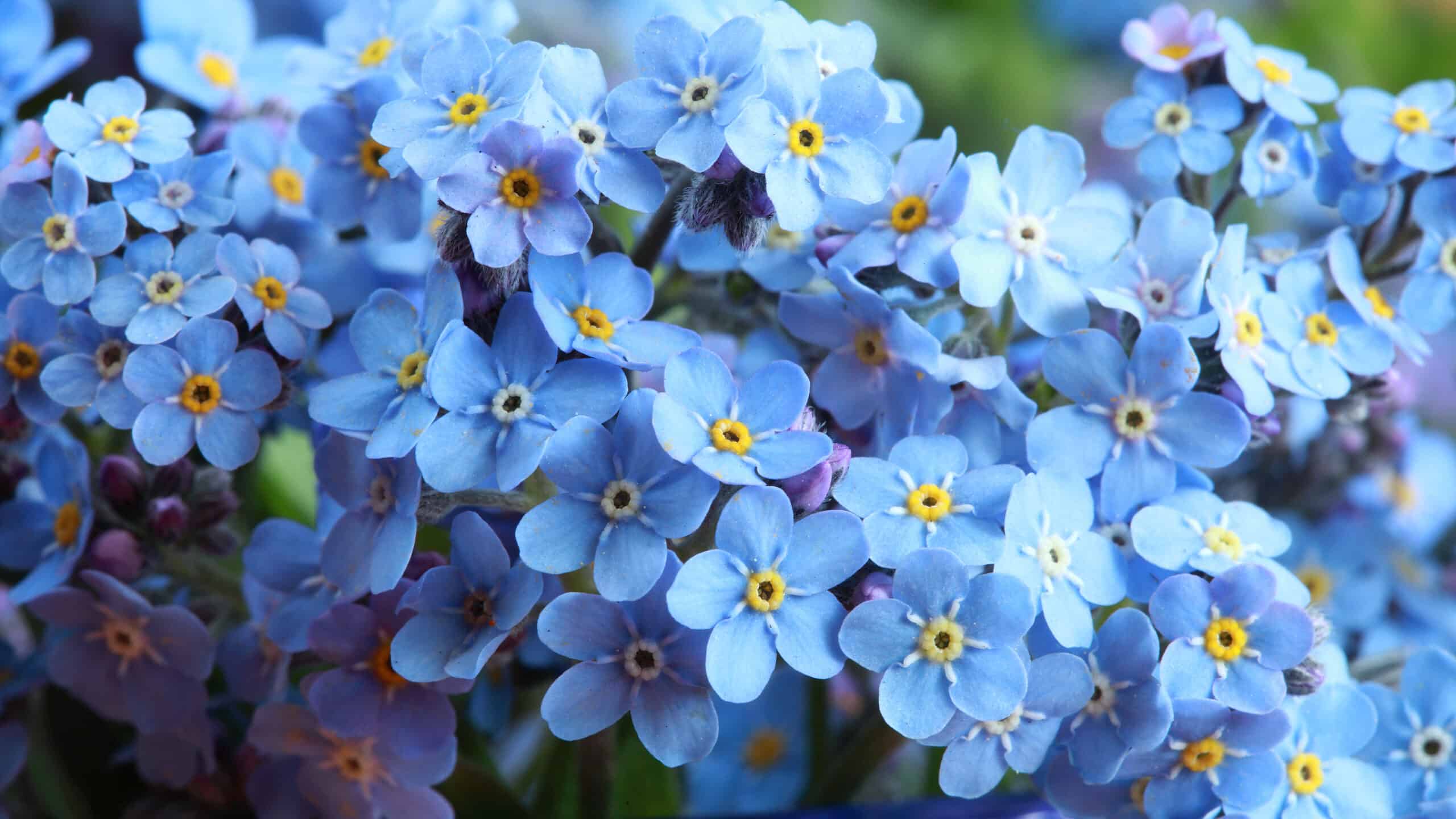After a long, dreary, gray winter, we all want to welcome the spring season with a burst of color. And the more colors, the better! As you consider the beautiful reds and yellows of your tulips and the white and golden hues of your daffodils, why not expand the color palette of your garden or flowerbeds? Here are nine beautiful blue flowers that will add to the vibrancy of your springtime display.
1. Hyacinths
It should be noted that the common name “hyacinth” is often applied to both the Hyacinthus and Muscari genera. The plants are not technically related, but they are similar in both appearance and care requirements. For this article, we’ll follow the common practice of treating them interchangeably.
There is a wide variety of hyacinths to choose from, with around 60 cultivars sold commercially today. Some of these varieties feature beautiful blue colors, ranging from light powdery blue to deep blue/purple blooms. Blue hyacinth varieties include the Blue Star, Blue Jacket, Blue Grape, Dark Eyes, Delft Blue, and Blue Festival hyacinths.
Hyacinths are bulbous spring flowers. The bulbs need to be planted in late summer or early fall, roughly eight weeks before the first frost is expected. Choose a sunny spot with well-draining soil. If the spot tends to hold water, it can lead to bulb rot. Add a little 10-10-10 bulb fertilizer when you plant the bulbs. After that, just wait until spring and then enjoy the blooms. Hyacinths are resilient, low-maintenance perennial flowers that add bright, easy spring color to your garden.
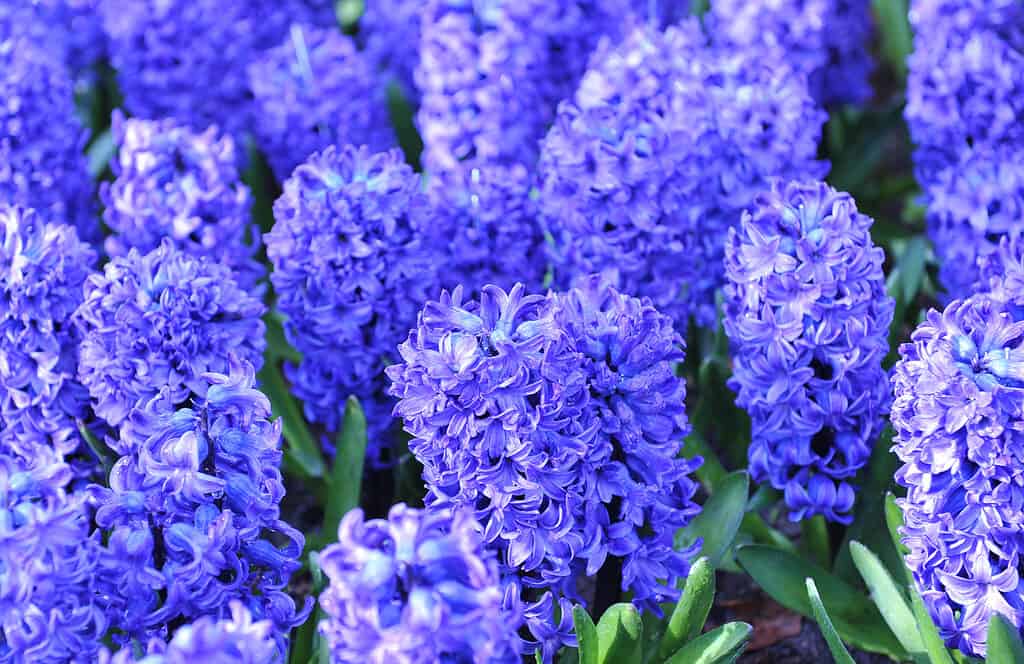
Bluestar hyacinths are a fragrant and bright spring flower.
©Sergey V Kalyakin/Shutterstock.com
| Hyacinth Facts | |
|---|---|
| Botanical name | Hyacinthus orientalis |
| Common names | Hyacinth, Common Hyacinth, Dutch Hyacinth, Garden Hyacinth |
| USDA hardiness zones | 4-8 |
| Sun exposure | Full, partial |
| Mature size | 6-12 inches tall, 3-6 inches wide |
| Bloom time | Spring |
| Flower colors | Blue, purple, pink, red, white |
| Toxicity | Toxic to pets and humans |
2. Nemesia
Nemesia flowers are native to South Africa. They are generally small plants that make wonderful edging or ground cover, although the size can vary depending on the species or hybrid in question. If you are growing nemesia from seed, planting should be about eight weeks before the first chance of frost. If you choose to grow from a nursery start, don’t plant it until the chance of frost is over for the season. Nemesia can be grown in a large number of plant hardiness zones, so check below for the average dates of the last frost in your zone.
- Zone 2 – May 15-22
- Zone 3 – May 1-16
- Zone 4 – April 24-May 12
- Zone 5 – April 7-30
- Zone 6 – April 1-21
- Zone 7 – March 22-April 3
- Zone 8 – March 13-28
- Zone 9 – February 6-28
- Zone 10 – No usual frost
Nemesia colors vary widely, but the blue varieties are among the loveliest of them all. Popular blue hybrids and cultivars include Bluebird, Poetry Blue, Blue Gem, Cherry Blue, Honey Blue with Eye, and Dark Blue nemesia.
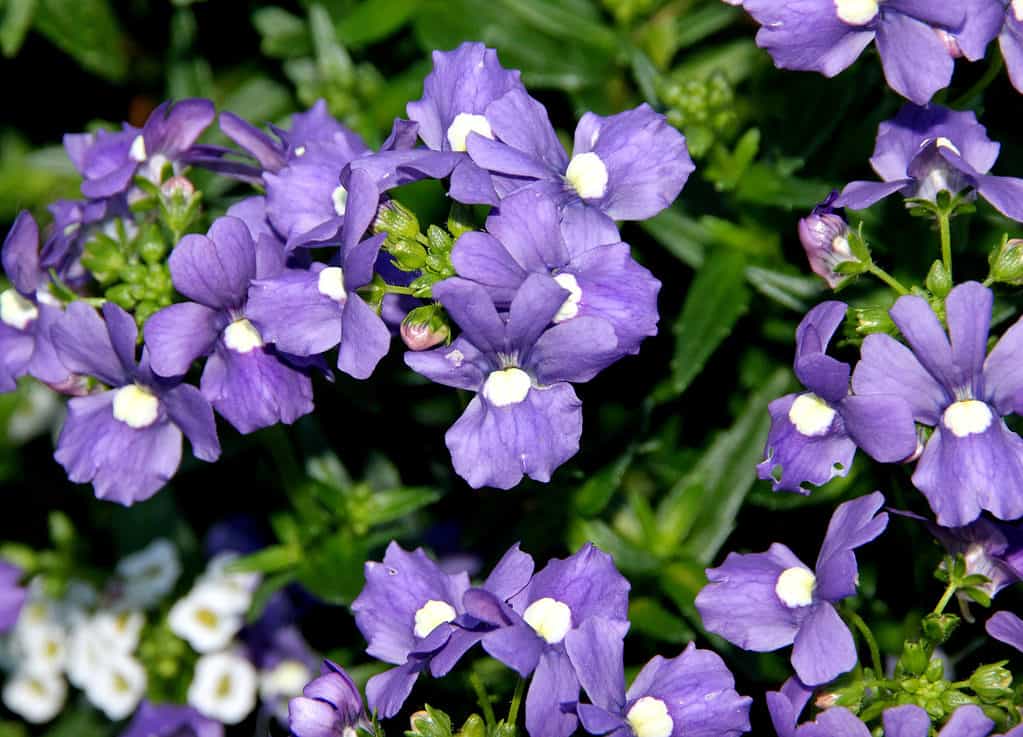
Bluebird nemesia feature blue-purple flowers with pale yellow to nearly white eyes.
©Gurcharan Singh/Shutterstock.com
| Nemesia Facts | |
|---|---|
| Botanical name | Nemesia spp. |
| Common names | Nemesia, Cape Jewels |
| USDA hardiness zones | 2-10 |
| Sun exposure | Full, partial |
| Mature size | 8-24 inches tall (species vary) |
| Bloom time | Spring, Summer |
| Flower colors | Blue, pink, red, orange, white, bi-color |
| Toxicity | Non-toxic |
3. Love-In-A-Mist
This memorable flower has an equally memorable name: love-in-a-mist. The common name comes from the fennel or fern-like foliage that seems to form a “mist” around the flower. This shroud of “misty” bracts is just part of this flower’s appeal, though. The blooms are showy and vibrant, with five petal-like sepals and smaller petals beneath the stamens. Love-in-a-mist Is just the ticket if you want to add a unique look to your spring flower beds!
Many varieties come in blue hues, from pastels to bright and brilliant. Some of the most popular blue varieties include Miss Jekyll Blue, Miss Jekyll Dark Blue, Miss Jekyll Indigo, Blue Midget, and Cambridge Blue. In case you’re wondering, the Miss Jekyll varieties are named for Gertrude Jekyll, an important and influential 20th-century gardener.
The love-in-a-mist flower isn’t necessarily a long-lived plant, but it is self-seeding. There’s a good chance that new flowers will be showing themselves when the older flowers die off during the growing season. You can also help this along by replanting new flowers throughout the blooming season to keep your display at its peak.
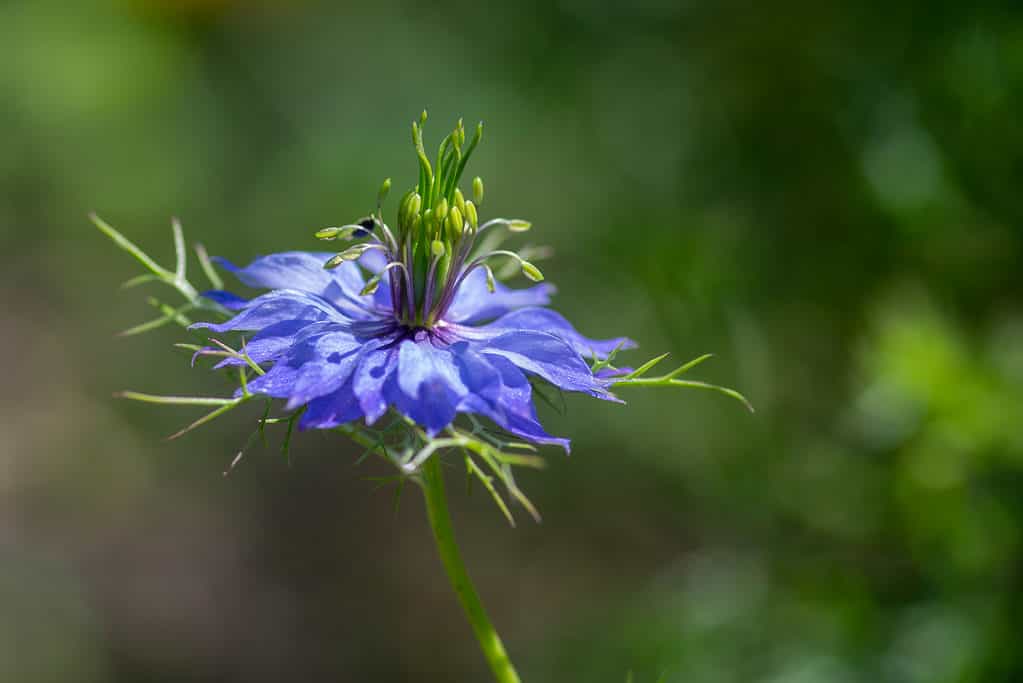
The love-in-a-mist flower features showy blossoms shrouded in a “mist” of bracts.
©Iva Vagnerova/Shutterstock.com
| Love-In-A-Mist Facts | |
|---|---|
| Botanical name | Nigella damascena |
| Common names | Love-in-a-mist, nigella |
| USDA hardiness zones | 2-11 |
| Sun exposure | Full, partial |
| Mature size | 8–20 inches tall, 3–6 inches wide |
| Bloom time | Spring, Summer, and Fall |
| Flower colors | Blue, pink, white, and purple |
| Toxicity | Toxic to humans |
4. Petunia
In an article about amazing blue spring flowers, it may seem a little strange to include petunias. Petunias come in virtually every color imaginable except true blue. While there are some other true blue flowers available (we’re discussing some of them in this article), true blue is actually one of the rarest flower colors found in nature or through hybridization. As you browse your local garden center or surf the internet, remember that color names are sometimes used rather loosely in the plant world. Blue is often applied to plants with blue and/or purple blooms.
Petunias that are classified as blue could be more accurately described as bluish-purple (and some are just plain purple!). But if you’re looking for an easy kinda-sorta-blue-like color to add to your spring flower bed, the petunia is a classic choice. Remember, when you see photos of true blue petunias on the internet, it’s a good bet those pictures have been Photoshopped. If you order petunias online and expect to receive true blue flowers, you’ll probably just be singing the blues when they arrive.
Blue (okay… bluish) petunia hybrids include Surfinia Heavenly Blue, Damask Blue, Wave Blue, Frost Blue, Supertunia Blue Skies, Capri Blue, Carpet Blue, Daddy Blue, Mambo Blue, Night Sky, and Storm Deep Blue.

Petunias come in a range of vibrant colors, including “blue.”
©Deniss Grigorjevs/Shutterstock.com
| Petunia Facts | |
|---|---|
| Botanical name | Petunia spp. |
| Common names | Petunia |
| USDA hardiness zones | 10-11 (when grown as a perennial) |
| Sun exposure | Full |
| Mature size | 6–24 inches tall, 6-36 inches wide |
| Bloom time | Spring, Summer, and Fall |
| Flower colors | Blue, orange, red, green, white, yellow, pink, purple |
| Toxicity | Non-toxic |
5. Cornflower
The common name of the cornflower comes from its native origin as a pasture flower in Europe and Asia. Many considered it to be more of a nuisance weed than a wildflower, and it has been mostly eradicated from its wild native range. It does make a lovely ornamental, though. It’s also one of the easiest flowers to grow, making it ideal for novice gardeners.
The flower features small blooms, less than two inches in diameter, that resemble tiny carnations. These blooms are magnets for butterflies, bees, and other pollinators. Cornflower blooms appear mid to late spring and will usually last until mid-summer. While there are cultivars that feature other colors, the most popular and easy-to-find cornflower varieties are blue. This flower is a no-fuss, super-easy way to add some lovely blue to your springtime gardens.
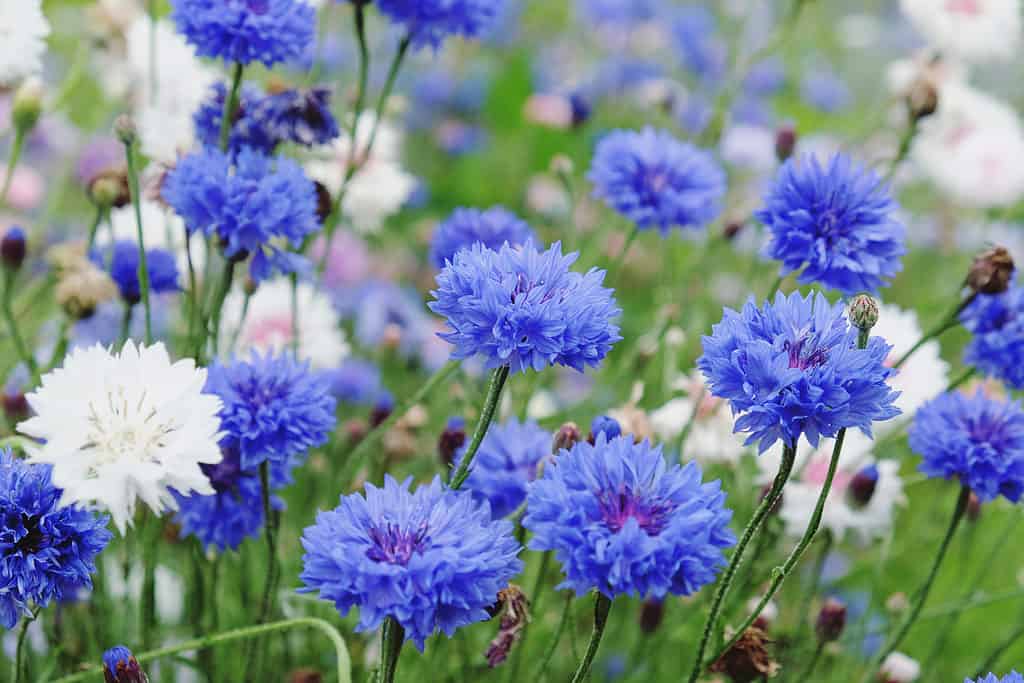
Cornflowers add a bright violet-blue to your spring display.
©Alex Manders/Shutterstock.com
| Cornflower Facts | |
|---|---|
| Botanical name | Centaurea cyanus |
| Common names | Cornflower, bachelor’s button |
| USDA hardiness zones | 2-11 |
| Sun exposure | Full, partial |
| Mature size | 12-48 inches tall, 10-12 inches wide |
| Bloom time | Spring, Summer |
| Flower colors | Blue, purple, white, red, pink |
| Toxicity | Non-toxic (although it is sometimes classified as toxic to cats) |
6. Eastern Bluestar
Native to the U.S. midwest, the eastern bluestar thrives in a wide variety of hardiness zones. It is a shrub-like plant that features small flowers that are a lovely powder blue. These star-shaped blooms show up in late spring and last into the early summer. And, as an added bonus, the foliage turns to a golden yellow in the fall. This one plant gives you multiple seasons of color in your garden display.
Hummingbirds and butterflies love the flowers of the eastern bluestar flowers, while deer do not. The leaves contain a toxic white latex that repels deer, rabbits, and other herbivores who may like to munch on your flowers.
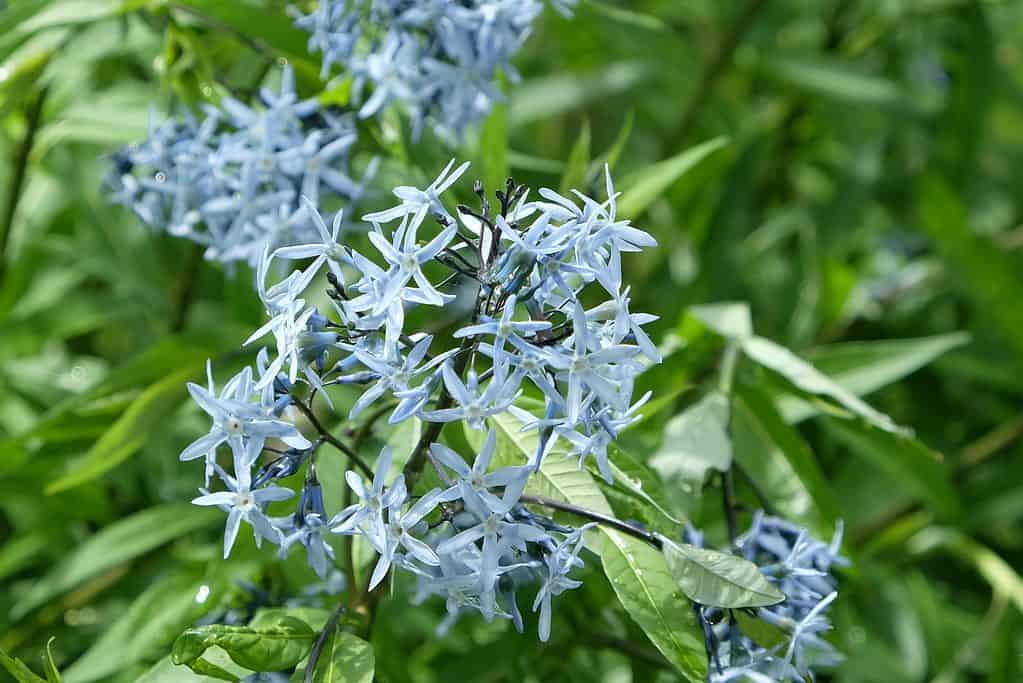
The star-shaped blooms of the eastern bluestar have a perfect shade of springtime light blue.
©Alex Manders/Shutterstock.com
| Eastern Bluestar Facts | |
|---|---|
| Botanical name | Amsonia tabernaemontana |
| Common names | Eastern bluestar, common bluestar, bluestar flower, bluestar |
| USDA hardiness zones | 3-9 |
| Sun exposure | Full, partial |
| Mature size | 12-36 inches tall, 12-24 inches wide |
| Bloom time | Spring, Summer |
| Flower colors | Blue |
| Toxicity | Mildly toxic to humans and pets |
7. Forget-Me-Nots
The blooms of forget-me-nots are quite small, measuring less than a half-inch at maturity. But the tiny blooms are also quite numerous, so they provide an attractive boost of color to your springtime gardens and beds. Forget-me-nots have come to symbolize love, devotion, respect, and faithfulness. These reasons, combined with the flower’s simple beauty, make the forget-me-not a popular choice for weddings, often appearing in bridal bouquets and wedding party boutonnieres.
These little flowers will bring pollinators, including lots of butterflies, to your garden. They are also one of the few true blue flowers on the market. And, for a short time before the flowers bloom, the buds will appear pink. Just another splash of color for your display! These flowers are lovely on multiple levels. It’s important to note that forget-me-nots reseed quickly and easily, so much so that they are now considered invasive in some areas. Be sure to check the guidelines in your locality before planting forget-me-nots.
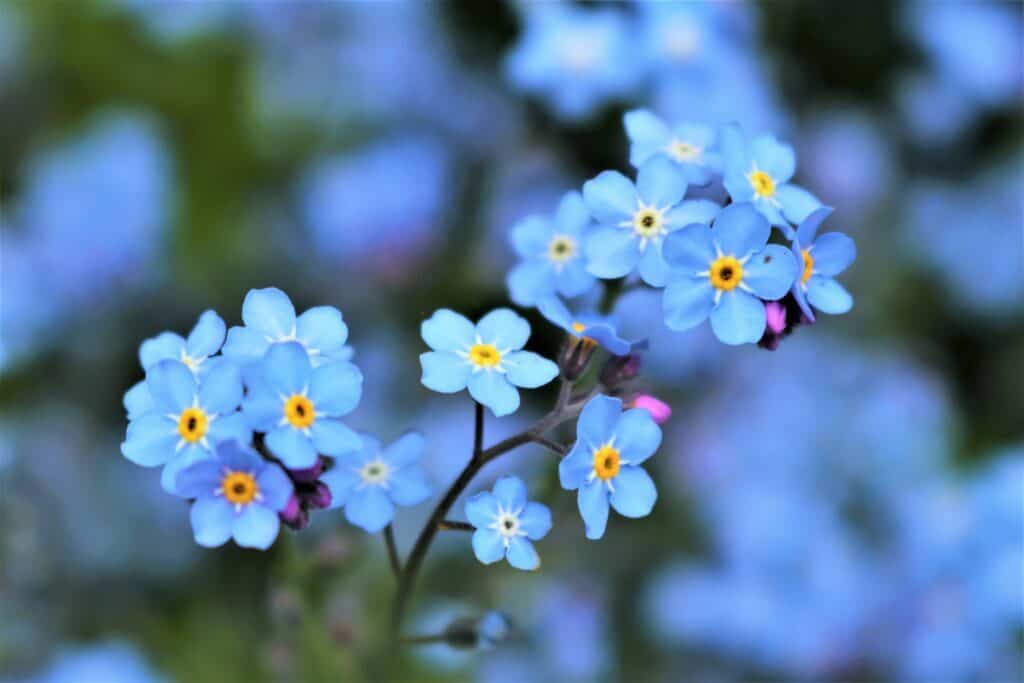
The forget-me-not is one of the rare true blue flowers.
©iStock.com/Agnieszka Klimaszewska
| Forget-Me-Not Facts | |
|---|---|
| Botanical name | Myosotis sylvatica |
| Common names | Forget-me-not |
| USDA hardiness zones | 3-8 |
| Sun exposure | Full, partial |
| Mature size | 5-12 inches tall, 5-12 inches wide |
| Bloom time | Spring, Summer |
| Flower colors | Blue, pink, yellow, white |
| Toxicity | Non-toxic |
8. Violas
Violas typically bloom in cooler weather, making them great early spring flowers. There are over 500 species in the Viola genus. But, when gardeners consider violas, they often think specifically about pansies. Pansies and violas are often grouped together to the point where the names have come to be used interchangeably. It can be a bit confusing, so let’s simplify the whole thing. Pansies are hybrids derived from violas. So, to put it succinctly, all pansies are violas, but not all violas are pansies.
If you’re looking for colorful, versatile, easy-to-grow flowers, pansies, and violas, check all of those boxes. They grow well in gardens and wooded spaces, as well as containers and hanging baskets. And as one final interesting bonus, you can eat them! All parts of the viola and pansy plants are edible. They make interesting additions to salads, with their mild, floral flavor. They can also be candied for confectionary uses, such as cake decorating. Caution: only consume them if they are grown organically. If you treat these flowers with chemicals such as pesticides or fertilizers, do not eat them!

Pansies are one of the most popular violas due to their interesting shape and vibrant color.
©Ken Kojima /Shutterstock.com
| Viola Facts | |
|---|---|
| Botanical name | Viola spp. |
| Common names | Viola, Johnny-jump-up, violet, sweet violet, pansy |
| USDA hardiness zones | 3-8 |
| Sun exposure | Full, partial |
| Mature size | 4-10 inches tall, 4-10 inches wide |
| Bloom time | Spring, Fall |
| Flower colors | Blue, purple, yellow, orange, white, red |
| Toxicity | Non-toxic |
9. Virginia Bluebells
The Virginia bluebell is a wildflower native to the eastern United States. They typically grow in flood plains and moist woodland areas. These flowers also make a great addition to your spring beds and gardens. The bloom season begins with gorgeous purple/pink buds. The buds then open to fragrant, trumpet-shaped flowers consisting of five petals. The blooms are a lovely pastel blue, although there are also rarer pink and white varieties, as well. The smooth, oval leaves are green, with hues of gray and blue. Virginia bluebells bloom early in the spring and are among the first flowers to be visited by pollinators such as butterflies and bees. They are also deer-resistant, adding another layer of appeal to gardeners.
This Flower Is Shady (In a Good Way)
If you have a shady, damp site in your landscape where you’d like to add some color, you definitely want to get to know the Virginia bluebell. It is the only flower explored in this article that thrives in partial to full shade. It also craves rich, moist soil, so it might be your answer if there are parts of your property that don’t drain as well. These flowers will burst with color in places where many other flowers will struggle or fail to thrive. Virginia bluebells are classified as threatened in much of their native range. This is primarily due to habitat destruction and local flood prevention measures. The flower is important for pollinators, especially bees. By planting Virginia bluebells, you can help the bees in your area while beautifying your landscape in the early spring. Win, win!
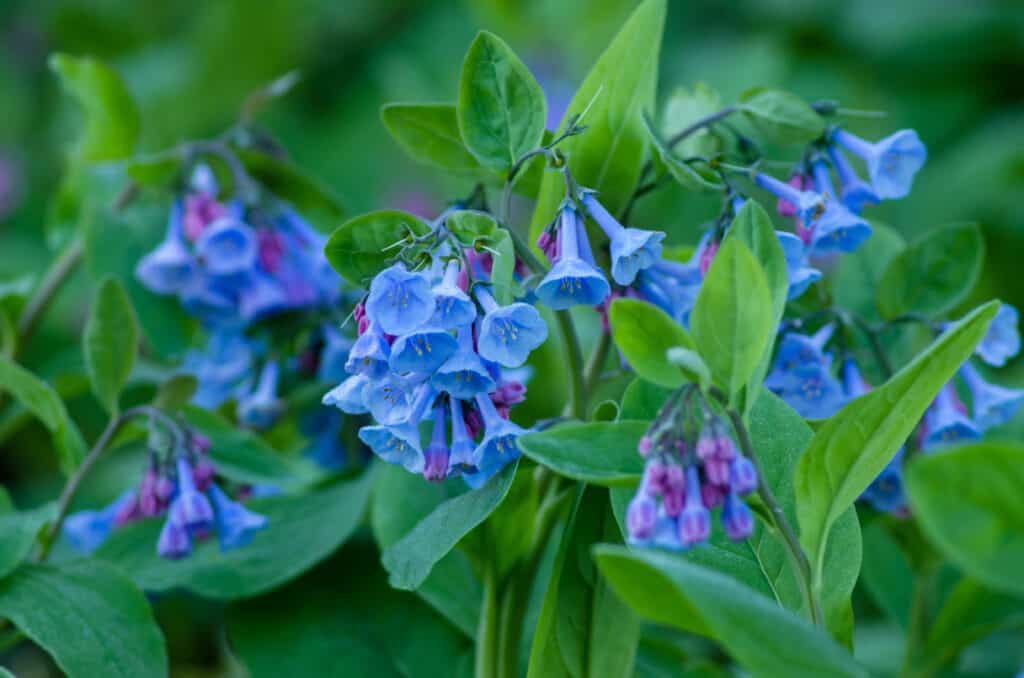
The Virginia Bluebell flowers feature blue trumpet-shaped flowers.
©iStock.com/Joshua Moore
| Virginia Bluebell Facts | |
|---|---|
| Botanical name | Mertensia virginica |
| Common names | Virgina bluebell |
| USDA hardiness zones | 3-8 |
| Sun exposure | Partial to full shade |
| Mature size | 12-24 inches tall, 12-24 inches wide |
| Bloom time | Spring, Summer |
| Flower colors | Blue |
| Toxicity | Toxic to pets and humans |
Get the Springtime Blues!
When you’re ready to trade in the winter “blahs” for the springtime blues, these blue beauties are ready for you. They are sure to liven up your landscape when the long-awaited spring season finally rolls around.
Thank you for reading! Have some feedback for us? Contact the AZ Animals editorial team.

